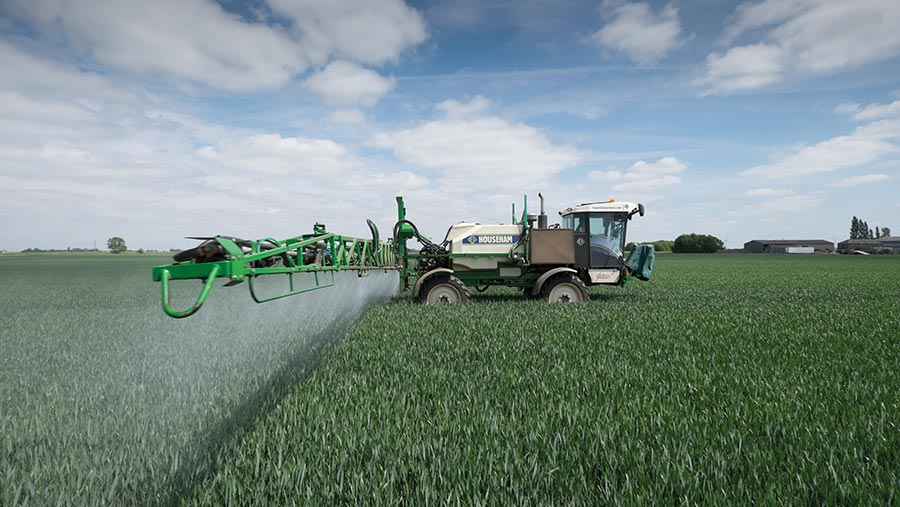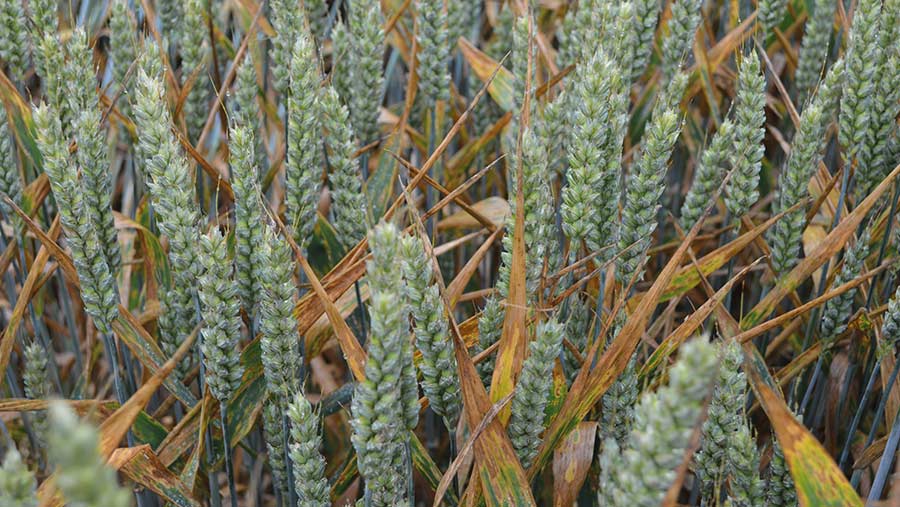Two new fungicides to fight septoria in wheat grower’s plans
 © Tim Scrivener
© Tim Scrivener Two recently launched blockbuster wheat fungicides gave very similar yields on Julian Gibbons’ Hampshire farm last year, and he plans to use both this spring to counter his biggest disease worry – septoria.
Mr Gibbons applied the two products – Univoq and Revystar – across 74ha of the winter wheat variety Crusoe, which resulted in a negligible gap between the two for disease control and yield response, and he sees them as complementary to use at the T1 and T2 timings this spring.
Univoq, only approved last March, contains the active fenpicoxamid, which has a new site of action, plus the widely used azole prothioconazole.
Revystar, which had its first full season of use in 2021, contains a new azole mefentrifluconazole plus the SDHI fluxapyroxad.
“Both were neck and neck in terms of performance, and the resulting yields were not that much different, so I will look to use both of them this season,” he tells Farmers Weekly.

Julian Gibbons © MAG/David Jones
See also: Cereals 2021: Two wheat varieties succumb to septoria strains
Dry spring weather
His Crusoe wheat received no T0 fungicide last spring due to dry weather and the SDHI-azole product Ascra at T1 in late April.
Then 40ha of the variety received 1.25 litres/ha of Univoq and the remaining 34ha of Crusoe had 1 litre/ha of Revystar at the flag-leaf T2 timing, with both treated with an azole mix of prothioconazole and tebuconazole as a head spray at T3.
He also applied a strip of Revystar through a field using Univoq and, vice versa, with a Univoq strip through a Revystar field to give the most accurate comparison.
The only differences he noticed was that when the T1-T2 gap was inadvertently stretched to five weeks due to wet weather, the Revystar seemed to work best, suggesting it showed a better curative or “kick-back” effect, while the Univoq showed a little better persistence.
Mr Gibbons usually tries to hold back his T1 spray as long as possible until late April to avoid a big T1-T2 gap, but when the interval was extended, to stretch from 22 April to 28 May, on some of his fields due to bad weather, the Revystar appeared to perform better.
However, he see the two products as complementary and, if used at T1 and T2 this season, they would give the opportunity of using an SDHI at the T3 spray timing in a very wet, disease-prone year, as Univoq does not contain an SDHI and only two SDHIs can be used in one season.
Key fungicide products
- Univoq Picolinamide fenpicoxamid (Inatreq) + azole prothioconazole
- Revystar SDHI fluxapyroxad + azole mefentrifluconazole (Revysol)
- Ascra SDHIs bixafen and fluopyram + azole prothioconazole
- Aviator SDHI bixafen + azole prothioconazole
Parting company
The lack of sunlight in the early summer led to lower yields than usual, with Crusoe producing just under 8t/ha, whereas Mr Gibbons’ five-year average with the variety is 9.5t/ha.
After this low yield, a low Hagberg and the lack of a nearby outlet – after the Hovis mill in Southampton closed a few years ago – he decided to part company with Group 1 milling varieties.
This season, with no Group 1 Crusoe, he has expanded his area of Extase and Graham and his 160ha wheat this year is in a ratio of 60:40 in favour of Extase.
This variety is favoured for its good resistance to septoria and the chance of a small price premium as a Group 2 milling wheat.
Last season, Mr Gibbons spent £64/ha on a fungicide programme with Extase and £73/ha on feed wheat Graham with no T0 applied.
The difference was that Extase had Aviator applied at T1 and Graham saw Ascra, and while both had Ascra at T2 the product rate on the Graham was increased.
Both had a T3 of the azole tebuconazole plus the strobilurin azoxystrobin.
The resultant yields were that Extase harvested at 8t/ha and Graham a little higher at 8.25t/ha.

Severe septoria in wheat © MAG/David Jones
Programme for the spring
For this coming season, he is again planning on applying no T0, as yellow rust is not a major threat on the farm, and both varieties were drilled relatively late (10-16 October), so reducing their susceptibility to septoria.
The T1 will likely be an SDHI-based product – either Ascra or, more likely, Revystar.
The T2 is likely to be Univoq and with this product’s persistence and the two varieties having generally good disease resistance scores, he hopes not to have to apply a T3 or reduce his spend on this ear spray.
“I hope this will give us good persistence so we don’t have to overspend at T3,” he says.
The launch of Univoq – the product will have its first full season of use in 2022 – comes at a time when there are only two classes of fungicides with good systemic activity against septoria, namely azoles and SDHIs.
So the use of the picolinamide group (as in Univoq) will give growers a third group of systemics to help fight septoria resistance to fungicides
The efficacy of these two older groups of fungicides – azoles and SDHIs – is on the wane, so the use of this new group will help fight resistance, while the introduction of the new azole mefentrifluconazole, which shows the same activity prothioconazole did 10-15 years ago, will also help.
Wheat disease resistance rating |
||||
| Variety | Septoria one-year | Septoria three-year | Yellow rust | Brown rust |
| Crusoe | 5.9 | 6.2 | 9 | 3 |
| Extase | 7.3 | 7.8 | 8 | 7 |
| Graham | 6.4 | 6.7 | 7 | 5 |
| Disease resistance ratings are on a 1-9 scale where 9 shows good resistance and 1 is very susceptible. One-year septoria ratings are include to reveal the influence of the 2021 season, which reflects the influence of the variety Cougar and its parentage of many varieties, after septoria variants were able to overcome resistance in Cougar. | ||||
Two fungicides compared
The two new fungicide products were “almost inseparable” in terms of septoria control, but Univoq edged ahead in terms of yield in the 2021 harvest season due to its greater persistence, independent trials show.
Jonathan Blake, technical director of crop protection at crop consultant Adas, said the two products plus Ascra will be very valuable tools for wheat growers in the coming season, with Univoq and Revystar giving similar levels of control of septoria.
“They were similar in efficacy in terms of septoria control, with Univoq giving a slightly higher yield in 2021, probably due to its persistence,” he says.
The AHDB fungicide response trials focus on giving only one fungicide treatment over the season, rather a series of spays, to compare different products.
Comparing Univoq and Revystar, Mr Blake says both give similar control of yellow rust, with Revystar having an edge on brown rust.

